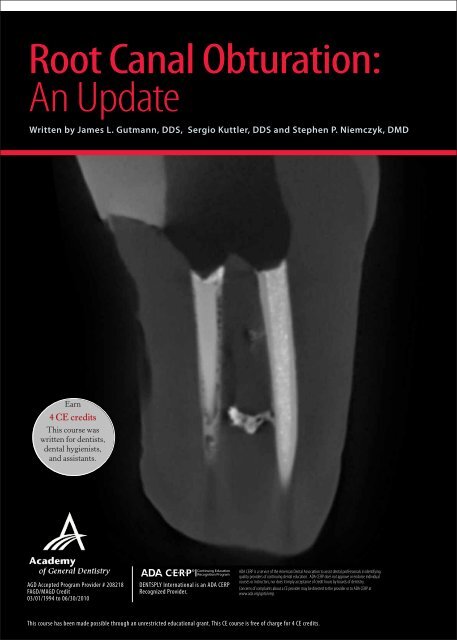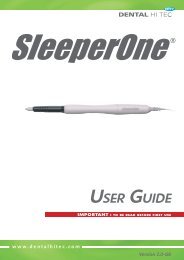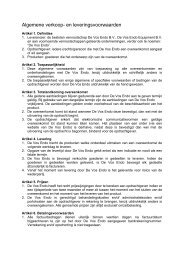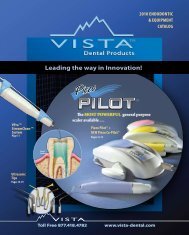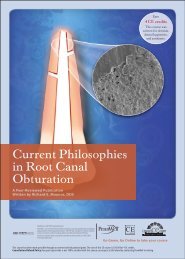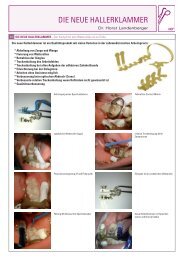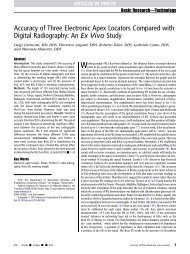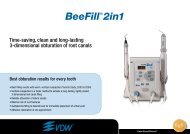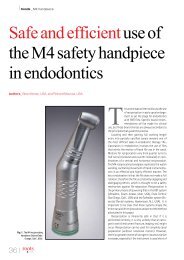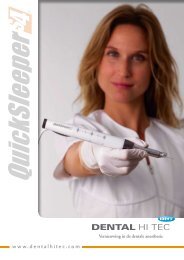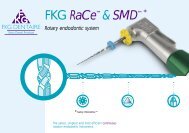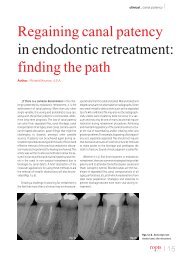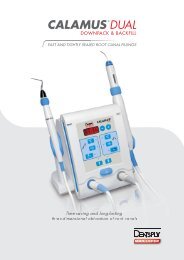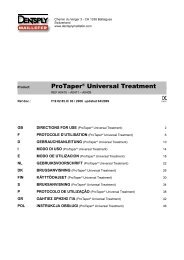Root Canal Obturation: An Update - De Vos Endo BV
Root Canal Obturation: An Update - De Vos Endo BV
Root Canal Obturation: An Update - De Vos Endo BV
Create successful ePaper yourself
Turn your PDF publications into a flip-book with our unique Google optimized e-Paper software.
pellets similar in shape and size to gutta-percha materials.Resin-based cones containing methacrylate resin, fillers,bioactive glass, and polymers are available that can be handledsimilarly to gutta-percha and can be used with a lateralor vertical compaction technique. Resin-based materials canalso be delivered via a heated syringe (Obtura gun, SpartanObtura). Since resin-based materials require a slightly moistenvironment, it is important to avoid using any dessicatingsolutions, such as alcohol, during root canal preparation.Further, if sodium hypochlorite or peroxide was used duringroot canal preparation, this must be thoroughly removedprior to using a resin-based material as it would reduce theability of the resin material to bond. Similarly, the smearlayer must also be thoroughly removed.Prefabricated ObturatorsGutta-percha can also be formed on a plastic carrier or corecarrier.Prefabricated obturators were first described in 1978by William Ben Johnson. 79 The prototype for the obturatorhad been prenotched K-files wrapped in gutta-percha (handformed) that were then heated over a flame until the surfaceglistened and expanded. These prenotched “obturators”were inserted into the canal and apical pressure appliedwhile the handle was twisted off (Figure 11).Figure 11. Prototype obturatorPlus, ProTaper ® Universal and ProSystem GT ® Obturators(<strong>De</strong>ntsply, Tulsa <strong>De</strong>ntal), and Soft-Core ® (Soft-Core ®Texas, Inc.).Figure 12. Calamus®Current plastic obturators are available in a nonvented shapewith a taper of around 0.04 (<strong>De</strong>nsfil) and a vented shapewith the same taper (Thermafil Plus). Both are biologicallyinert. 80 The carrier is thick with a thinner outer coating ofgutta-percha, which helps to reduce material shrinkage asthe gutta-percha cools in the canal (Figure 13). A ventedprefabricated obturator helps the flow of gutta-percha duringplacement and also aids in retrieval of the obturatorshould retreatment be necessary.For sizes 40 and below in the Thermafil series, an insolubleliquid crystal plastic is used. For size 45 and above solublepolysulfone polymer is used. All of these use a size verifier tohelp select the correct size obturator, as do ProTaper Universalcarriers, which start at a .04 taper. Systems that do not use asize verifier include the ProSystem GT carriers and GT SeriesX carriers, which are made in a variety of tapers between 0.04and 0.12.Figure 13. Carrier and gutta-percha coatingPrefabricated obturators were introduced in 1988 (Thermafil)using first a stainless steel and subsequently a titaniumcore, coated with gutta-percha. Plastic obturators were firstoffered in 1992. Since then, a number of prefabricated obturatorsystems have been introduced, including one that doesnot involve thermosoftening of the gutta-percha (SimpliFil,Discus <strong>De</strong>ntal) but instead is used cold with only the apicalarea coated in gutta-percha, and after placement the carrieritself is removed.A recently developed prefabricated obturator utilizes aresin-based system (RealSeal One, Sybron <strong>Endo</strong>) and isused with, and bonded to, methacrylate resin-based sealermaterial and is first held in its custom oven and thermosoftened.Other systems use thermosoftened gutta-percha,including Calamus® (Tulsa <strong>De</strong>ntal, <strong>De</strong>ntsply) (Figure 12),Successfil® (Hygienic-Coltene-Whaledent, Inc.), Gutta-Flow ® , System B <strong>Obturation</strong> System, Thermafil, ThermafilCarriergutta-perchaventingThe first case below shows a step-by-step procedure usingGT ® Series X obturation, and the second shows use of theProTaper ® Universal obturator.Case 1. GT® Series X obturationFollowing complete shaping and cleaning, the canals shouldbe thoroughly dried. For the obturator, the size matching the6 www.ineedce.com
last instrument taken to working length should be selected(Figure 14). It is vital that the calibration rings (measuringmarks) on the carrier are used as opposed to actually measuringthe obturator from the tip. There is more gutta-perchathan plastic carrier at the apical end of the obturator and itis this gutta-percha that is intended to flow and fill the spaceahead of the plastic.The plastic core delivers the gutta-percha to the full workinglength. If necessary, for shorter canals, excess gutta-perchashould be peeled from the coronal end to facilitate setting of theworking length indicator. Additionally, if BioPure ® MTAD ® isto be used in the canal space, it must be the last liquid irrigantin the canal space and should therefore be incorporated afterchecking the fit of the size verifiers.A ProPost ® drill with an eccentric tip can be used to cut thepost channel through the obturator (note that most post drillscannot efficiently cut a solid core obturator).Figure 16. Placing sealant with a paper pointFigure 14. Workinglength calibrationFigure 15. GT® Series Xobturator ovenFigure 17. Obturator at working lengthThe obturator is then heated in the GT (or GT® SeriesX) obturator oven to ensure even heating of the gutta-perchaand consistent flow of the gutta-percha in the canal (Figure15). During the heating process, sealer is placed in the canalspace. A non-eugenol sealer is recommended for use withGT ® Series X obturators, with a thin coat applied using apaper point (Figure 16). After placing the sealer, excess shouldbe blotted out with a paper point. It is critical that only a tinyamount of sealer be used since increasing the amount of sealerwill predispose to material overextension beyond the confinesof the canal. The obturator is then placed in the canal with asmooth motion until the rubber stopper touches the referencepoint on the crown of the tooth, indicating it has reached workinglength (Figure 17). It is important not to rotate the obturatoror to push it with excessive force into the canal. Prior tocutting off the handle, the length and quality of the fill can beconfirmed with a radiograph. The handle of the obturator canbe cut off after several seconds of cooling of the gutta-perchawith a Prepi ® bur, a round bur, an ultrasonic tip, or a Touch’n Heat instrument. If using a Prepi ® bur, water spray shouldnot be used as this would needlessly soak the pulp chamberand any other open canals, thereby creating more work incleanup. Allow for the gutta-percha to cool back to a hardconsistency prior to making post space so that the obturator isnot dislodged by the post drill; therefore it is recommended towait five minutes after placement before cutting the obturator.Figure 18. Finished caseCase 2. ProTaper® Universal/Thermafil® obturatortechniqueThe ProTaper ® and Thermafil ® Plus obturators are a solidcore of plastic covered in a layer of gutta-percha. As in the caseabove, thorough drying and cleaning of the canals is required.In this case, the obturator is selected using the size verifier toascertain the size required for a passive fit at working length inthe canal (Figures 19,20). For canals shorter than 18 mm, thewww.ineedce.com 7
carrier can be stripped back from 18 and the rubber stopperrepositioned, while for canals longer than 24 mm, the lengthcan be measured on the handle and part of the handle cut back(taking care to preserve half of the handle length so that theobturator can rest on the oven hanger arm). The obturator isheated using the ProTaper ® Universal obturator oven, whichis designed specifically to guarantee full and uniform guttaperchaheating. A light coating of sealer should be placed tothe full working length of the root canal space, then the heatedobturator is placed in the canal with a smooth motion until therubber stopper touches the reference point on the crown of thetooth, indicating it has reached working length. The obturatorshould not be rotated or pushed into the canal with excessiveforce. There is adequate time after taking the obturator out ofthe oven to methodically place the gutta-percha without rushing.The length and quality of the fill can be confirmed witha radiograph prior to cutting off the handle using one of thetechniques described above in Case 1. Post space preparationcan occur after five minutes.Figure 19. Working length indicatorsFigure 20. Size verifierFigure 21. Finished caseSummaryAppropriate cleaning and shaping of canals and obturationwith an apical and coronal seal are essential for successfulclinical outcomes in root canal therapy. While gutta-perchacones, used together with a sealer/cement, may not meet allcriteria for the ideal root filling material, it has withstood thetest of time and is the standard material used for root canalobturation. Contemporary techniques include the use ofgutta-percha carrier-based obturators as well as thermosoftenedsyringed gutta-percha and mechanically softened guttapercha.Other materials used include resin-based carriersand sealers. For successful outcomes, the appropriate use ofthe selected materials and techniques, radiographic controlduring the different phases of endodontic therapy, and a highdegree of clinical expertise are required.References1 Naidorf IJ. Clinical microbiology in endodontics. <strong>De</strong>nt ClinNorth Am. 1974;18:329.2 Buckley M, Spångberg L. The prevalence and technical quality ofendodontic treatment in an American subpopulation. Oral SurgOral Med Oral Pathol Oral Radiol <strong>Endo</strong>d. 1995;79:92.3 Gutmann JL. Clinical, radiographic, and histologic perspectiveson success and failure in endodontics. <strong>De</strong>nt Clin North Am.1992;36:379.4 Rud J, <strong>An</strong>dreasen JO. A study of failures after endodontic surgeryby radiographic, histologic and stereomicroscopic methods. Int JOral Surg. 1972;1:311.5 Sjögren U, Hägglund B, Sundqvist G, Wing K. Factors affectingthe long-term results of endodontic treatment. J <strong>Endo</strong>d.1990;16:498.6 Saunders WP, Saunders EM. Coronal leakage as a cause offailure in root canal therapy: a review. <strong>Endo</strong>d <strong>De</strong>nt Traumatol.1994;10:105.7 Vire DE. Failure of endodontically treated teeth. J <strong>Endo</strong>d.1991;17:338.8 Ray HA, Trope M. Periapical status of endodontically treatedteeth in relation to the technical quality of the root filling and thecoronal restoration. Int <strong>Endo</strong>d J. 1995;28:12-8.9 Gutmann JL, Dumsha TC, Lovdahl PE. Problem solving inendodontics. 4th edition, St Louis, 2006, Mosby-Elsevier, Chapter 1.10 American Association of <strong>Endo</strong>dontists Guide to Clinical<strong>Endo</strong>dontics, Chicago, 2004.11 Gutmann JL, Dumsha TC, Lovdahl PE: Problem solving inendodontics. 4th edition, St Louis, 2006, Mosby-Elsevier, Chapter8.12 American Association of <strong>Endo</strong>dontists Guide to Clinical<strong>Endo</strong>dontics, Chicago, 2004.13 Khatib ZZ et al. The antimicrobial affect of various endodonticsealers. Oral Surg Oral Med Oral Pathol Oral Radiol <strong>Endo</strong>d.1990;70:784.14 Peters LB, Wesselink PR, Moorer WR. The fate and role ofbacteria left in root dentinal tubules. Int <strong>Endo</strong>d J. 1995;28:95.15 Heling I, Chandler NP. The antimicrobial effect within dentinaltubules of four root canal sealers. J <strong>Endo</strong>d. 1996;22:257.16 Baumgartner G et al. Enterococcus faecalis type strain leakagethrough root canals filled with gutta-percha/AH Plus or Resilon/Epiphany. J <strong>Endo</strong>d. 2006;33:45.17 Lai CC et al. <strong>An</strong>timicrobial activity of four root canal sealersagainst endodontic pathogens. Clin Oral Investig. 2001;5:236.18 Gomes BP et al. In vitro evaluation of the antimicrobial activity offive root canal sealers. Braz <strong>De</strong>nt J. 2004;15:30.19 Al-Gutmann JL. Adaptation of injected thermoplasticized guttaperchain the absence of the dentinal smear layer. Int <strong>Endo</strong>d J.1993;26:87.20 Sen BH, Piskin B, Baran N. The effect of tubular penetration ofroot canal sealers on dye microleakage. Int <strong>Endo</strong>d J. 1996;29:23.21 Oksan T, Aktener BO, Sen BH, Tezel H. The penetration of8 www.ineedce.com
oot canal sealers into dentinal tubules: a scanning electronmicroscopic study. Int <strong>Endo</strong>d J. 1993;26:301.22 Wennberg A, Ørstavik D. Adhesion of root canal sealers tobovine dentine and gutta-percha. Int <strong>Endo</strong>d J. 1990;23:13.23 Lee K-W et al. Adhesion of endodontic sealers to dentin andgutta-percha. J <strong>Endo</strong>d. 2002;28:684.24 Eldeniz AU, Erdemir A, Belli S. Shear bond strength of three resinbased sealers to dentin with and without smear layer. J <strong>Endo</strong>d.2005;31:293.25 Kokkas AB et al. The influence of the smear layer on dentinaltubule penetration depth by three different root canal sealers: anin vitro study. J <strong>Endo</strong>d. 2004;30:100.26 ANSI/ADA specification no. 57 for endodontic filling materials.J Am <strong>De</strong>nt Assoc. 1984;108:88.27 Cobankara FK et al. The quantitative evaluation of apical sealingof four endodontic sealers. J <strong>Endo</strong>d. 2006;32:66.28 Facer SR, Walton RE. Intracanal distribution patterns of sealersafter lateral condensation. J <strong>Endo</strong>d. 2003;29:832.29 Tagger M et al. Interaction between sealers and gutta-perchacones. J <strong>Endo</strong>d. 2003;29:835.30 Granche D et al. <strong>Endo</strong>dontic cements induce alterations in thecell cycle of in vitro cultured osteoblasts. Oral Surg Oral MedOral Pathol Oral Radiol <strong>Endo</strong>d. 1995;79:359.31 Briseno BM, Willerhausen B. <strong>Root</strong> canal sealer cytotoxicity onhuman gingival fibroblasts. I. Zinc oxide-eugenol based sealers, J<strong>Endo</strong>d. 1990;16:383.32 Brodin P, Røed A, Aars H, Ørstavik D. Neurotoxic effects ofroot filling materials on rat phrenic nerve in vitro. J <strong>De</strong>nt Res.1982;61:1020.33 Sonat B, Dalat D, Günhan O. Periapical tissue reaction to rootfillings with Sealapex. Int <strong>Endo</strong>d J. 1990;23:46.34 Briseno BM, Willerhausen B. <strong>Root</strong> canal sealer cytotoxicity onhuman gingival fibroblasts. III. Calcium hydroxide-based sealers.J <strong>Endo</strong>d. 1992;18:110.35 Briseno BM, Willerhausen B: <strong>Root</strong> canal sealer cytotoxicity onhuman gingival fibroblasts. II. Silicone- and resin-based sealers, J<strong>Endo</strong>d. 1991;17:537.36 Schwarze T et al. The cellular compatibility of five endodonticsealers during the setting period. J <strong>Endo</strong>d. 2002;28:784.37 Layhausen G et al. Genotoxicity and cytotoxicity of the epoxyresin-based root canal sealer AH plus. J <strong>Endo</strong>d. 1999;25:109.38 Hensten A, Jacobsen N. Allergic reactions in endodontic practice.<strong>Endo</strong>d Topics. 2005;12:44.39 Dahl JE. Toxicity of endodontic filling materials. <strong>Endo</strong>d Topics.2005;12:39.40 Huang TH et al. <strong>Root</strong> canal sealers induce cytotoxicity andnecrosis. J Mater Sci Mater Med. 2004;15:767.41 Gluskin A. Mishaps and serious complications in endodonticobturation. <strong>Endo</strong>d Topics. 2005;12:52.42 Ørstavik D. Materials used for root canal obturation: technical,biological and clinical testing. <strong>Endo</strong>d Topics. 2005;12:25.43 Langeland K. <strong>Root</strong> canal sealants and pastes. <strong>De</strong>nt Clin NorthAm. 1974;18:309.44 Holland R, de Souza V. Ability of a new calcium hydroxide rootcanal filling material to induce hard tissue formation. J <strong>Endo</strong>d.1985;11:535.45 Kontakiotis E, Panopoulos P. pH of root canal sealers containingcalcium hydroxide. Int <strong>Endo</strong>d J. 1996;29:202.46 Zmener O, Pameijer CH. Clinical and radiographical evaluationof a resin-based root canal sealer: a 5-year follow-up. J <strong>Endo</strong>d.2007;33:676-9.47 Ørstavik D. Materials used for root canal obturation: technical,biological and clinical testing. <strong>Endo</strong>d Topics. 2005;12:25.48 Barbosa SV, Burkard DH, Spångberg LSW. Cytotoxic effects ofgutta-percha solvents. J <strong>Endo</strong>d. 1994;20:6.49 Metzger Z et al. Residual chloroform and plasticity in customizedgutta-percha master cones. J <strong>Endo</strong>d. 1988;14:546.50 Wong M, Peters DB, Lorton L. Comparison of gutta-percha fillingtechniques: three chloroform gutta-percha filling techniques: part2. J <strong>Endo</strong>d. 1982;8:4.51 Gutmann JL, Heaton JF. Management of the open (immature)apex. II. Non-vital teeth. Int <strong>Endo</strong>d J. 1981;14:173.52 Gutmann JL, Dumsha TC, Lovdahl PE. Problems in root canalobturation. Problem solving in endodontics. 4th edition, St Louis,Elsevier-Mosby, 2006.53 Kaplowitz GJ. Evaluation of gutta-percha solvents. J <strong>Endo</strong>d.1990;16:539.54 Haas SB et al. A comparison of four root canal filling techniques.J <strong>Endo</strong>d. 1989;15:596.55 Keane K, Harrington GW. The use of a chloroform-softenedgutta-percha master cone and its effect on the apical seal. J<strong>Endo</strong>d. 1984;10:57.56 McDonald NM, Vire DE. Chloroform in the endodonticoperatory. J <strong>Endo</strong>d. 1992;18:301.57 Metzger Z et al. Apical seal by customized versus standardizedmaster cones: a comparative study in flat and round canals. J<strong>Endo</strong>d. 1988;14:381.58 Friedman CE, Sandrik JL, Heuer MA, Rapp GW. Compositionand mechanical properties of gutta-percha endodontic points. J<strong>De</strong>nt Res. 1975;54:921.59 Moorer WR, Genet JM. <strong>An</strong>tibacterial activity of gutta-perchacones attributed to the zinc oxide component. Oral Surg OralMed Oral Pathol Oral Radiol <strong>Endo</strong>d. 1982;53:508.60 Moorer WR, Genet JM. Evidence for antibacterial activity ofendodontic gutta-percha cones, Oral Surg Oral Med Oral PatholOral Radiol <strong>Endo</strong>d. 1982;53:503.61 Whitworth J. Methods of filling root canals: principles andpractices. <strong>Endo</strong>d Topics. 2005;12:2.62 Gutmann JL, Dumsha TC, Lovdahl PE. Problem solving inendodontics. 4th edition, St Louis, Elsevier-Mosby, 2006.63 Ibid.64 Kuttler Y. Microscopic investigation of root apexes. J Am <strong>De</strong>ntAssoc. 1955;50(5):544–52.65 Grove CJ. Why root canals should be filled to the dentinocementaljunction. J Am <strong>De</strong>nt Assoc. 1930;17:293.66 Wu M-K, Wesselink PR, Walton RE. Apical terminus location ofroot canal treatment procedures. Oral Surg Oral Med Oral PatholOral Radiol <strong>Endo</strong>d. 2000;89:99.67 Orban B. Why root canals should be filled to the dentinocementaljunction. J Am <strong>De</strong>nt Assoc. 1930;7:1086.68 Seltzer S, Bender IB, Turkenkopf S. Factors affecting successfulrepair after root canal therapy. J Am <strong>De</strong>nt Assoc. 1963;67:651.69 Hasselgren G. Where shall the root filling end? NY State <strong>De</strong>nt J.1994;60(6):34.70 Grahnén H, Hansson L. The prognosis of pulp and root canaltherapy: a clinical and radiographic follow-up examination,Odontol Revy. 1961;12:146.71 Seltzer S, Naidorf I. Flare-ups in endodontics. II. Therapeuticmeasures. J <strong>Endo</strong>d. 1985;11:559.72 Sjögren U, Hägglund B, Sundqvist G, Wing K. Factors affectingthe long-term results of endodontic treatment. J <strong>Endo</strong>d.1990;16:498.73 Swartz DB, Skidmore AE, Griffin JA. Twenty years of endodonticsuccess and failure. J <strong>Endo</strong>d. 1983;9:198.74 Gutmann JL, Leonard JE. Problem solving in endodontic workinglength determination. Comp Contin Educ <strong>De</strong>nt. 1995;16:288.75 Seltzer S. <strong>Endo</strong>dontology: biologic considerations in endodonticprocedures. 2nd edition, Philadelphia, Lea & Febiger. 1998.76 Budd CS, Weller RN, Kulild JC. A comparison ofthermoplasticized injectable gutta-percha obturation techniques.J <strong>Endo</strong>d. 1991;17:260.77 Gutmann JL. Adaptation of injected thermoplasticized guttaperchain the absence of the dentinal smear layer. Int <strong>Endo</strong>d J.1993;26:87.78 Wu MK, Shemesh H, Wesselink PR. Limitations of previouslypublished systematic reviews evaluating the outcome ofendodontic treatment. Int <strong>Endo</strong>d J. 2009;42(8):656-66. Epub2009 Jun 22.79 Johnson, WB. A new gutta-percha technique. J <strong>Endo</strong>d.1978;4(60):184-8.80 Foong W, Sutow E, Zakariasen K, Hidi P, Jones D. Cytotoxicitytesting of an endodontic obturating device. J <strong>Endo</strong>d. 1993;19(Abstract 74):202.Author ProfileThe authors of this course, James L. Gutmann, DDS,Sergio Kuttler, DDS and Stephen P. Niemczyk, DMD,are all board-certified endodontists.www.ineedce.com 9


